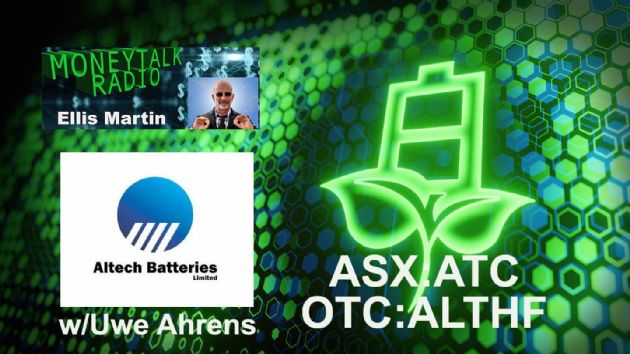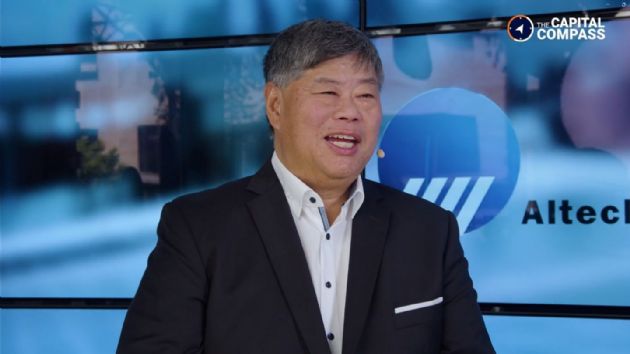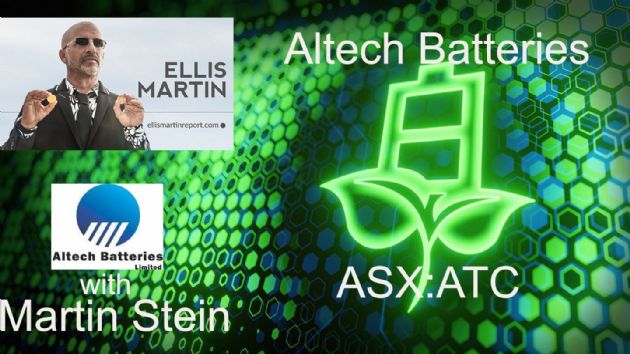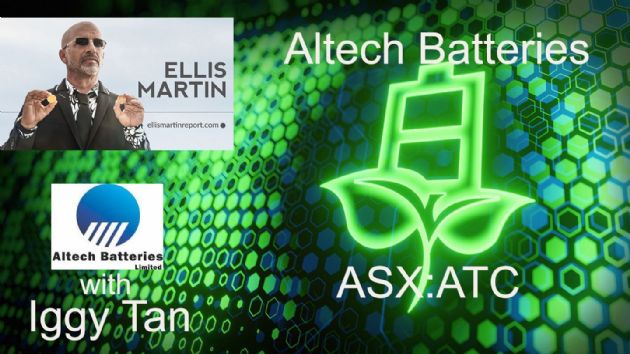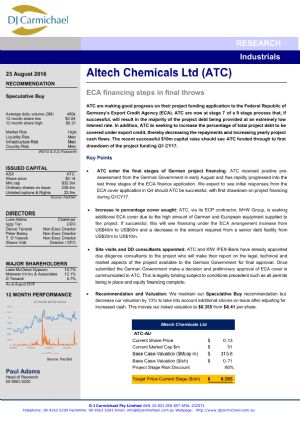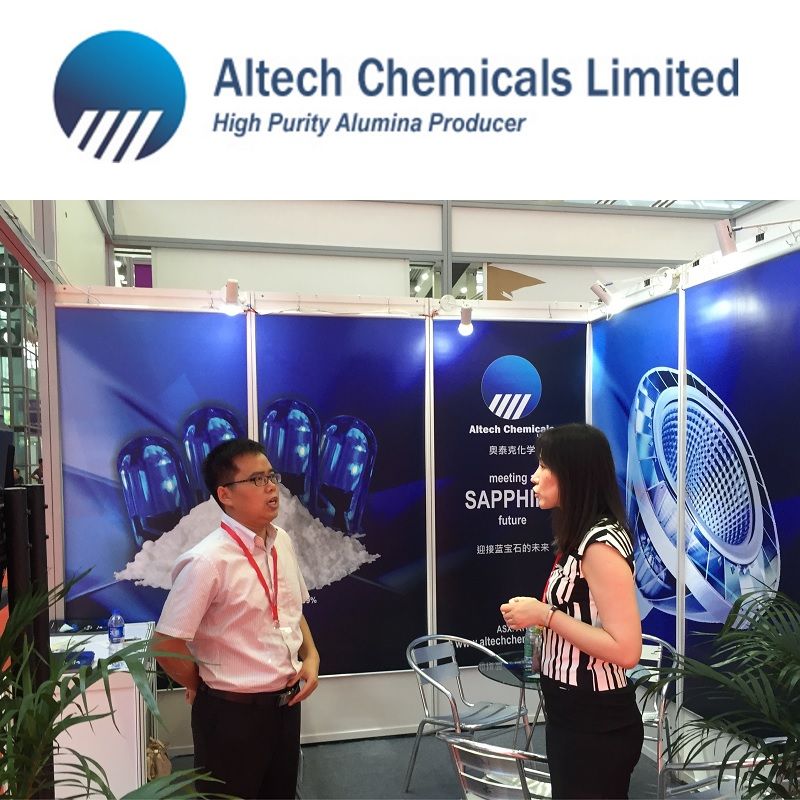
Maiden Ore Reserve at Meckering Kaolin Deposit
Perth, Oct 11, 2016 AEST (ABN Newswire) - Altech Chemicals Limited (Altech/the Company) ( ASX:ATC) is pleased to announce the estimation of a maiden Ore Reserve based on the production of high purity alumina (HPA) using feedstock from its 100%-owned Meckering Kaolin Deposit (M70/1334), Western Australia (Meckering). The Ore Reserve was derived from a Mineral Resources estimation at Meckering, which was delineated for the purpose of HPA production.
ASX:ATC) is pleased to announce the estimation of a maiden Ore Reserve based on the production of high purity alumina (HPA) using feedstock from its 100%-owned Meckering Kaolin Deposit (M70/1334), Western Australia (Meckering). The Ore Reserve was derived from a Mineral Resources estimation at Meckering, which was delineated for the purpose of HPA production.
Highlights
- Maiden Ore Reserve of 1.2Mt @ 30% Al2O3 (JORC 2012) at Altech's Meckering Kaolin Deposit (M70/1334)
- Ore Reserve and mine design will provide immediate kaolin feedstock for initial 30 years mine-life
- Mineral Resources (JORC 2012) estimation of 12.7Mt @ 29.5% Al2O3
- The Resource supports the proposed HPA plant for over 250 years
A maiden Ore Reserve is estimated at 1.2 million tonnes @ 30% Al2O3 (alumina) in the minus 300 micron (µm) kaolin fraction with a cut-off grade of 25% Al2O3. The Ore Reserve at Meckering is more than sufficient to support the proposed HPA processing operation (ore delivery rate of 41,000tpa) for the initial stage 1 mine-life of 30 years.
A Mineral Resource estimated 12.7 million tonnes @ 29.5% Al2O3 (alumina) in the minus 300 micron (µm) kaolin fraction with a cut-off grade of 25% Al2O3. The Mineral Resources estimation at Meckering is potentially sufficient to support its proposed HPA production for over 250 years.
The Mineral Resources estimate is inclusive of the above Ore Reserve estimate and based on data from the Company's April 2016 drilling program and subsequent test work results.
Altech managing director Mr Iggy Tan commented, "The Company is pleased to present both the maiden Ore Reserve and Mineral Resources estimation.
"The Ore Reserve statement is a significant milestone that confirms an initial stage 1 30 year mine-life at Meckering, providing over 1.2Mt of high-quality, alumina-rich kaolin feedstock to supply the proposed HPA plant.
"The Mineral Resource estimate is sufficient to supply the proposed HPA operation for over 250 years which will also allow further capacity expansions in the future.
"The next step of the process to bring Meckering into production is the submission of the mining proposal and mine closure plan as part of the approvals required for the commencement of construction in early 2017", he concluded.
ORE RESERVE STATEMENT (JORC 2012)
Material Assumptions
Material assumptions and outcomes were detailed in the Company's bankable feasibility study (BFS) which was first released in June 2015 and updated in March 2016.
The key assumptions are:
- A Meckering mining operation with kaolin ore shipped to Malaysia at a rate of 41,000 tpa for processing and production of 4,000 tpa of HPA product
- HPA processing, underpinned by batch testing, involves leaching the -300µm fraction of the mined kaolin ore
The Company's BFS indicated that:
- The kaolin resource can easily meet the processing feed requirements for the production targets of the proposed HPA operation.
- HPA product price of US$23,000 per tonne.
- The 30-year HPA project is profitable, with an estimated NPV of US$357.5 million at a discount rate of 9%, a payback period of 3.7 years and an IRR of 33.3%.
- Project capital expenditure of US$78.7 million and operating costs of US$9,070 per tonne.
- NPV calculations are before interest and tax.
- The cost of the proposed Meckering mining operation accounts for about 2% of the total HPA production cost.
Ore Reserve Classification
The Ore Reserve was prepared in accordance with the JORC Code 2012 by Orelogy Consulting Pty Ltd (Orelogy), a highly-experienced independent mine planning consultancy group based in Perth, Western Australia. Orelogy was first appointed by the Company in 2014 and has since been working closely with the Company to progress the Meckering mine development and approvals proceedings.
The BFS pit designs were updated based on the Mineral Resource provided (released as part of this announcement) and the proposed Malaysian HPA processing plant feed requirements. Proved Ore Reserves are based on Measured resource materials and Probable Ore Reserves are based on Indicated resource materials, constraint by the pit designs.
The Meckering Kaolin Deposit Ore Reserve estimate is summarised in Tables 2 and 3 (refer to link below, with the estimation process summarised in Appendix 1 (Section 4 of JORC Table 1 (refer to link below) for the estimation and reporting of Ore Reserves).
Confidence in Modifying Factors
Analysis of the sensitivity of the Project NPV to changes in key assumptions or estimates used in the financial model (base case) shows that the NPV is most sensitive to a movement in the HPA selling price and/or a movement in the USD/AUD exchange rate. The Company believes that these parameters were estimated conservatively. The NPV is not as sensitive to changes in capital or operating costs.
An Integrated Risk Assessment has been undertaken including qualitative and quantitative analysis of the risks and uncertainties associated with the project's development. The assessment did not identify any risks that threaten the viability of the project.
Mining Method
A conventional open pit mine method was selected as the basis for the Company's BFS, suitable due to the near surface presence of the kaolin ore. No blasting is required due to the high weathered nature of the kaolin mineralisation. At Meckering, ore is hauled to the Run of Mine (RoM) stockpile and overburden is backfilled into the pit to minimise the footprint of the proposed operation. This method was tested and proven effective by trial mining activities carried out historically on the Meckering deposit.
The proposed pit at Altech's Meckering site was designed in nine (9) stages with overall wall angles and backfill rill angles of 35DEG ; these were geotechnically validated. The mine designs allow for practical minimum mining widths, ramp designs and adequate space for backfilling. The initial overburden material will be dumped into the existing pit and used for the construction of a pond for the discharge and evaporation of pit water. An ore loss of 10% was allowed to avoid contamination (dilution) of ore with overburden and sheeting materials.
Due to the relatively small quantities of ore extracted, and to maintain adequate efficiencies, mining will be undertaken once every three (3) years in two-month campaigns; a two-month campaign is sufficient to excavate and stockpile three (3) years' kaolin supply on the RoM stockpile pad.
Mining Method and Assumptions
The Company's HPA process involves beneficiating the Meckering RoM kaolin followed by calcination; acid leaching to produce aluminium chloride; crystallisation of aluminium chloride; two (2) stages of purification; roasting for acid recovery; and final calcination for the production of a finished HPA product.
HCl processing, underpinned by laboratory and batch testing, was demonstrated to be ideal for producing HPA, primarily due to the absence of sodium ions in the Company's kaolin feedstock. It is therefore very suited to the kaolin material of the Meckering deposit, which contains low levels of impurities and high alumina content. The metallurgical recovery was estimated at 34.5%.
Cut-off Grade
A cut-off grade of 25% Al2O3 was selected to provide the HPA processing plant in Malaysia with the optimum feed grade.
Estimation Methodology
The Ore Reserve estimate is the outcome of the March 2016 Bankable Feasibility Study with geological, geotechnical, mining, metallurgical, processing, engineering, marketing and financial considerations, including test work, followed by updated pit designs based on the Mineral Resource. The estimated NPV demonstrates that the HPA project is economical and robust; an Integrated Risk Assessment did not identify any risks that threaten the viability of the project.
Material Modifying Factors - Mining Lease
The Company's engagement with relevant stakeholders includes securing key landowner agreements; several meetings have been held with the Shire of Cunderdin council. Altech's mining tenement (M70/1334) was also granted on 19 May 2016.
Material Modifying Factors - Environmental
The proposed Meckering operation has been referred to the Western Australian state government for environmental approval. Baseline environmental surveys have been completed and investigations to date have not identified any environmental issues or potentially adverse impacts that would compromise approval of the project. The proposed campaign mining is considered a low-level extraction activity without the requirement for mine waste rock or process tailings storage facilities. Hence the permitting process is anticipated to be simple and straightforward.
The Company has received approval from the Department of Environment, Johor, Malaysia (DOE) of its Preliminary Site Assessment (colloquially referred to as a "PAT") for the proposed Malaysian HPA plant. In general, the approval of the PAT confirms that the proposed location of the HPA plant and its proposed activity are compatible with gazetted structure and local plans, surrounding land use, provision of set-backs or buffer zones and waste disposal requirements.
The DOE also advised that an Environment Impact Assessment (EIA) will not be required for the HPA plant.
Solid residue from the proposed HPA plant will predominantly be in the form of neutralised benign silica residue that will be made available to local brickworks or cement plants. Any residue from the plant will be neutralised and treated on-site and disposed of via local waste vendors. All process water from the plant will be treated on-site to established environmental standards.
The next approval stage for the HPA facility is the required approval and registration of air pollution control system, chimneys and fuel burning equipment. The HPA plant has been designed to meet international environmental standards as well as the standards of the Malaysian Environmental Quality Act 1974.
Material Modifying Factors - Infrastructure
The township of Meckering has good public road access and connections to the port of Fremantle. The Company's mining lease M70/1334 provides adequate space for the proposed operation including the RoM stockpile, container loading shed and evaporation pond. Power will be provided through a diesel generator and potable water will be trucked to site. The major service town of Northam is located about 30km from the mining lease.
The Tanjung Langsat Industrial Complex, Johor, Malaysia was selected as the location for the Company's proposed HPA plant. The Company has secured a ~4 hectare site in a section of the Tanjung Langsat Industrial Complex reserved for chemical facilities as the location for its HPA plant. Hydrochloric acid, power, water and natural gas are readily available, as is skilled local labour force.
MINERAL RESOURCES STATEMENT (JORC 2012)
Mineral Resources are reported inclusive of Ore Reserves and include all exploration and drilling information including subsequent data from test work. Previous work examining the economic potential of kaolin as a commercial clay product provided significant qualitative and geological information for the estimate. The estimate was undertaken by Geos Mining, independent geological consultants, in accordance with the JORC Code 2012 and follows the Company's BFS (June 2015, updated March 2016), which investigated the proposed HPA project's viability.
Geology
The Company's granted mining lease (M70/1334) lies in the south western part of the Yilgarn Craton, in an area with thick deeply weathered regolith profiles. The Meckering Kaolin Deposit is located in the southern part of the granulite facies metamorphic belt of rocks termed the Western Gneiss Terrane. This belt extends north-northwest across the Perth sheet area for over 120km and varies in width from 15 to 65km.
Geological mapping and drilling have enabled a regolith profile to be recognised comprising a thin soil cover over a pisolitic limonitic laterite. The laterite, which is usually two to six metres thick, is usually underlain by a mottled zone up to four metres thick, which may be replaced by a thin silcrete or siliceous horizon. A narrow band of weathered bedrock occasionally occurs either above or below the silcrete horizon or mottled zone. The mottled zone is then underlain by the kaolin pallid zone, which typically passes into weathered bedrock or banded sandy clay. At the proposed mine site the base of the mottled zone is less than 10m from the surface and the kaolin pallid zone (clay zone and the saprolite) is extensively developed, exceeding 40m in thickness in some places.
Drilling and Collar Surveys
All holes were reverse circulation (RC) air core. All collar co-ordinates drilled in 2016 were recorded in GDA94 Zone 50. Historical drilling locations were converted into this co-ordinate system. 2016 drill collar surveys were by RTK (Real Time Kinetic), where collars were not surveyed using this method (MK100-MK319) the RL of collars was derived from a digital terrain model (DEM). The DEM is accurate in z dimension for the classified resources.
This elevation model agrees with the RTK surveyed collars elevations.
Downhole Survey
Conventionally, no down-hole surveys were conducted during drilling. All drilling was undertaken at -90 degrees (vertical) and assumed representative of true thickness. The combined effects of the shallow drilling depth (<60m) and soft drill substrate are assumed to have minimised downhole deviation of the drill string. Any deviation from vertical is likely to be minor and not significant to the economic potential of the project.
Field Logging
During 2016 logging was conducted on RC drill chip and spoils, drill holes were geologically logged on a metre interval basis.
Sample Recovery
No measurement of sample recovery was made as the drilling process disturbs the sample in the process. As a result minor contamination (smearing down-hole) and minor error/s may be introduced into quantitative analysis. However, weights of the samples collected indicate sufficient representative material was collected for analysis.
Sample Collection
Reverse circulation (RC) air core drilling by the Company in April 2016 was used to obtain 1m down-hole interval samples. If the sample was white, off white or pale cream it was retained in full. The sample was bagged in plastic bags, assigned a unique sample number and grouped into batches for despatch. A total of 669 samples were collected from Altech's 2016 drilling.
Sample Processing & Analysis
All chemical analysis was undertaken using a Panalytical XRF (fusion) with lithium borate flux, except for B, U, Th where analyses were done by peroxide fusion and ICP. Loss on Ignition was analysed at 1000CDEG in a LECO furnace.
The minus 300 micron fractions were obtained by wet screening.
Nagrom Laboratories undertook all sample analysis and preparation for the Company's 2016 drilling at the Meckering Kaolin Deposit. Sue Border of Geos Mining visited the ISO90001 accredited facilities on 3 August 2016. Nagrom's facilities were found to be of a high standard and checks on wet screen sample preparation were observed to be clean, with no visible clay balls or obvious clays in the retained oversize fractions.
Field Standards and Duplicates
Samples from the existing pit were submitted for analysis (for reference material analysis), and were found to be comparable with previous bulk sample results from the same pit. Duplicates were taken at the drill rig at the rate of one every twenty samples. Sixteen (16) duplicates were weighed and analysed for moisture content, and one (1) for chemical analysis; results were satisfactory.
Drill sample reliability was checked by comparison with historic bulk sample pits and data was closely comparable.
One (1) 2016 hole was twinned with a historic hole. Twin holes compared very well on geological logging, visually estimated brightness and measured ISO brightness. The only direct bases for comparison were the 45 micron yield and the 45 micron fraction brightness, and sample intervals differed, but results were comparable.
Laboratory Quality Control
Examination of laboratory standards and duplicates indicate there is no cause for concern with any of the laboratory procedures or analytical accuracy. Laboratory duplicate samples were included in the sample stream to check the relative precision of the test work. At the request of Altech, XRF analysis was performed on both minus 300 and minus 500 fraction sizes. The main mineral occurring in the 300 to 500 micron fraction in this environment was quartz, and visual inspection of stored samples at Nagrom confirmed this to be the case. Therefore, these analyses were effectively duplicates, and taking into account the removed quartz, there is a consistent correlation between the duplicate pairs.
Bulk Density Data
Three holes were surveyed using Gamma and Density probes for the purposes of determining in-situ density.
Downhole densities were derived from the average between Long-Spaced density and Short-Spaced density from down-hole point reads, and corrected for moisture. The average dry density was 1.58g/cm3.
Data Handling & Storage
Geos Mining compiled newly acquired drilling and assay data into an exploration database prior to the resource estimation. Altech's project data was stored in a custom-designed Microsoft SQL Server 2008 R2 database.
Field observations were logged into purposed Excel spreadsheets, while laboratory assay reports were supplied as direct laboratory exports. All data uploaded to the project database occurred via software data importers to minimise data handling errors and perform routine validation.
Resource Estimation Procedures
Resource estimation was undertaken using Micromine 2014 software. A 50 by 50 by 5m block model was created in Micromine. Block dimensions were considered suited to the potential bench height in the Z dimension and appropriate to the drill spacing as holes range in separation from 200m to 23m. The parameters considered to have significant economic impact in the production of high purity alumina were interpolated into the block mode by ordinary kriging using variogram models. These were Al2O3, K2O, and Fe2O3 for the minus 300 micron assays and minus 300 micron Yield.
Three (3) passes were made to populate sufficient blocks to the bounds of potential mine planning. Search neighbourhoods were expanded from 150 to 300 and finally 500m in X and Y (Radius), Z was kept constant at 3m to sufficiently reflect the lateritic nature of the deposit, and still incorporate appropriate composites.
A wireframe was used in the estimate to constrain the final block model to within the outline of logged white kaolin. An additional constraint of -2% K2O was also applied during reporting that eliminated less weathered blocks not amenable to beneficiation, and that are likely to be harder and pose problems in mining.
After consideration of the mining method and likely pit wall slope only blocks 40m within the mining lease M70/1334 are reported as Mineral Resources.
The resource model was validated on a cross-sectional basis, superimposing composites, raw assays and block values in the same view. This allowed reconciliation of block grades with proximal samples and identification of any anomalies.
Note that for this resource, estimates of the elemental oxide content of the 300 micron size fraction in blocks is not to be confused with an estimate of elemental oxide of in situ un-sized material. To account for the material in the oversize fraction the yield of the 300 micron fraction must be used to adjust back to the as mined concentrations, if required. The estimated yield averages 68% and ranges from 44%-84%.
Resource Classification
The classification of Mineral Resources was made where adequate quantitative chemical data from the 2016 drilling was available to estimate the attributes of individual blocks or sufficient historical drilling existed to demonstrate geological continuity of the resources to extrapolate from the 2016 chemical assays. The logic of classification was based on variography, estimation pass and the number of distinct drill holes used to estimate each block. Categories were assigned to all blocks within the mining lease and resource shell within the silhouette of projected block outlines selected by the criteria in the following table (refer to link below). Resources exclude blocks 40m inside the mining lease bounds or those outside of the wireframe domain or blocks with over 2% K2O.
Cut-off Grade
The cut-off of 25% Al2O3 in minus 300 micron material is considered economically reasonable, based on the financial forecasts in the BFS. The preliminary financial forecasts are positive, and all aspects of production and marketing of the product HPA have been assessed and found viable.
Mining and Processing Factors
Resources have been restricted to within the area expected to be minable by the planned open pit mining method. Due to the planned processing of wet screening at minus 300 micron to upgrade the feedstock to the HPA plant, the yield and chemistry of the minus 300 micron fraction has been quoted for the resource.
Environmental
The environmental impact statement has been reviewed and there are no known environmental impediments to the development of the project.
Metallurgical
The results of the metallurgical test work indicate there is a viable method for the beneficiation of high purity alumina from the material contained in the Resources.
Radioactive Elements
Based on Uranium and Thorium ICP assays conducted on twenty (20) samples from four (4) holes within Measured and Indicated Resource areas, material would not be classed as radioactive material under IAEA safety standards that Western Australia uses to classify radioactive material. (International Atomic Energy Agency, 2012).
To view tables and figures, please visit:
http://abnnewswire.net/lnk/Q50655NP
About Altech Batteries Ltd
 Altech Batteries Limited (ASX:ATC) (FRA:A3Y) is a specialty battery technology company that has a joint venture agreement with world leading German battery institute Fraunhofer IKTS ("Fraunhofer") to commercialise the revolutionary CERENERGY(R) Sodium Alumina Solid State (SAS) Battery. CERENERGY(R) batteries are the game-changing alternative to lithium-ion batteries. CERENERGY(R) batteries are fire and explosion-proof; have a life span of more than 15 years and operate in extreme cold and desert climates. The battery technology uses table salt and is lithium-free; cobalt-free; graphite-free; and copper-free, eliminating exposure to critical metal price rises and supply chain concerns.
Altech Batteries Limited (ASX:ATC) (FRA:A3Y) is a specialty battery technology company that has a joint venture agreement with world leading German battery institute Fraunhofer IKTS ("Fraunhofer") to commercialise the revolutionary CERENERGY(R) Sodium Alumina Solid State (SAS) Battery. CERENERGY(R) batteries are the game-changing alternative to lithium-ion batteries. CERENERGY(R) batteries are fire and explosion-proof; have a life span of more than 15 years and operate in extreme cold and desert climates. The battery technology uses table salt and is lithium-free; cobalt-free; graphite-free; and copper-free, eliminating exposure to critical metal price rises and supply chain concerns.
The joint venture is commercialising its CERENERGY(R) battery, with plans to construct a 100MWh production facility on Altech's land in Saxony, Germany. The facility intends to produce CERENERGY(R) battery modules to provide grid storage solutions to the market.
| ||
|





